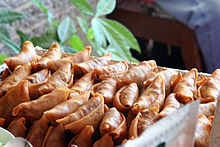검색결과 리스트
글
음식
2011. 10. 13. 22:46
Samosa
 A samosa is a stuffed pastry and a popular snack in South, Southeast, Central and Southwest Asia, the Arabian Peninsula, the Mediterranean, the Horn of Africa, North Africa and South Africa. It generally consists of a fried or baked triangular, semilunar or tetrahedral pastry shell with a savory filling, which may include spiced potatoes, onions, peas, coriander, and lentils, or ground lamb or chicken. The size and shape of a samosa, as well as the consistency of the pastry used, can vary considerably, although it is mostly triangular. Samosas are often served with chutney[citation needed] generally as an appetizer.Samosa (Hindi: समोसा) (English pronunciation: /səˈmoʊsə/) is used in South and Southeast Asian countries such as Nepal, Bengali: সিঙাড়া singara, Oriya: ષ્હિઙદ shingada, Punjabi: ਸਮੋਸਾ, Gujarati: સુમૉસ sumosa, Kannada: ಸಮೋಸಾ samosa, Malayalam: സമോസ, Marathi: समोसा, Tamil: சமோசா, Urdu: سموسه, sambusak (Arabic: سمبوسك sambūsak), samsa (pronounced [ˈsamsə]) or somsa in Turkic Central Asia (Kyrgyz: самса, [sɑ́msɑ]; Kazakh: самса, [sɑmsɑ́], Uzbek: somsa, [sɒmsa], Uyghur: سامسا, [sɑmsɑ́]), as well as Turkey (Turkish: 'samsa boreği'), sambusa among Arabs, Ethiopians, Somalis (Somali: sambuusa) and Tajiks (Tajik: самбӯса), sanbuse among Iranians (Persian: سنبوسه), samuza among Burmese or chamuca in the Lusophone world.The samosa has been a popular snack in South Asia for centuries. It is believed that it originated in Central Asia (where they are known as samsa) prior to the 10th century.Abolfazl Beyhaqi (995-1077), an Iranian historian has mentioned it in his history, Tarikh-e Beyhaghi. It was introduced to the Indian subcontinent in the 13th or 14th century by traders from the region.Amir Khusro (1253–1325), a scholar and the royal poet of the Delhi Sultanate, wrote in around 1300 that the princes and nobles enjoyed the "samosa prepared from meat, ghee, onion and so on".Ibn Battuta, the 14th century traveller and explorer, describes a meal at the court of Muhammad bin Tughluq where the samushak or sambusak, a small pie stuffed with minced meat, almonds, pistachio, walnuts and spices, was served before the third course, of pulao.
A samosa is a stuffed pastry and a popular snack in South, Southeast, Central and Southwest Asia, the Arabian Peninsula, the Mediterranean, the Horn of Africa, North Africa and South Africa. It generally consists of a fried or baked triangular, semilunar or tetrahedral pastry shell with a savory filling, which may include spiced potatoes, onions, peas, coriander, and lentils, or ground lamb or chicken. The size and shape of a samosa, as well as the consistency of the pastry used, can vary considerably, although it is mostly triangular. Samosas are often served with chutney[citation needed] generally as an appetizer.Samosa (Hindi: समोसा) (English pronunciation: /səˈmoʊsə/) is used in South and Southeast Asian countries such as Nepal, Bengali: সিঙাড়া singara, Oriya: ષ્હિઙદ shingada, Punjabi: ਸਮੋਸਾ, Gujarati: સુમૉસ sumosa, Kannada: ಸಮೋಸಾ samosa, Malayalam: സമോസ, Marathi: समोसा, Tamil: சமோசா, Urdu: سموسه, sambusak (Arabic: سمبوسك sambūsak), samsa (pronounced [ˈsamsə]) or somsa in Turkic Central Asia (Kyrgyz: самса, [sɑ́msɑ]; Kazakh: самса, [sɑmsɑ́], Uzbek: somsa, [sɒmsa], Uyghur: سامسا, [sɑmsɑ́]), as well as Turkey (Turkish: 'samsa boreği'), sambusa among Arabs, Ethiopians, Somalis (Somali: sambuusa) and Tajiks (Tajik: самбӯса), sanbuse among Iranians (Persian: سنبوسه), samuza among Burmese or chamuca in the Lusophone world.The samosa has been a popular snack in South Asia for centuries. It is believed that it originated in Central Asia (where they are known as samsa) prior to the 10th century.Abolfazl Beyhaqi (995-1077), an Iranian historian has mentioned it in his history, Tarikh-e Beyhaghi. It was introduced to the Indian subcontinent in the 13th or 14th century by traders from the region.Amir Khusro (1253–1325), a scholar and the royal poet of the Delhi Sultanate, wrote in around 1300 that the princes and nobles enjoyed the "samosa prepared from meat, ghee, onion and so on".Ibn Battuta, the 14th century traveller and explorer, describes a meal at the court of Muhammad bin Tughluq where the samushak or sambusak, a small pie stuffed with minced meat, almonds, pistachio, walnuts and spices, was served before the third course, of pulao.




RECENT COMMENT